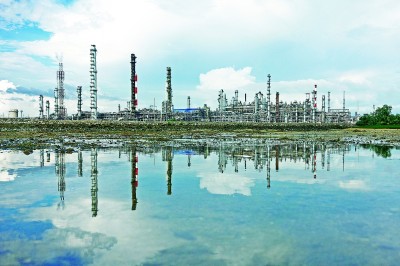【Year-end special】
Author: Yao Zhizhong (Researcher, Institute of World Economics and Politics, Chinese Academy of Social Sciences)
If one keyword is used to describe the main characteristics of the world economy in 2022, it may be “global inflation” that is most appropriate. The turbulent factors in the world order such as the Ukraine crisis, the impact of the epidemic, and the game of great powers have contributed to global inflation. The economies of all countries have been disturbed by global inflation, and many major economies are also exploring how to manage inflation. The response to inflation has triggered new world economic turmoil. Inflation remains elevated in some major economies through the end of 2022. Looking ahead to 2023, if countries do not deal with inflation properly, the world economy may be plunged into greater turmoil.
The picture shows an oil refinery photographed in Mohiroshima, Singapore.The picture is issued by Xinhua News Agency
The global inflation situation is not optimistic
According to the estimates of the International Monetary Fund, the world‘s average consumer price index will increase by 8.8% in 2022. Compared with the growth rate of 4.7% in 2021, the global inflation rate in 2022 has increased significantly, reaching the highest global inflation since the 21st century. Level.
Inflation in 2022 is universal across the globe. In addition to the relatively stable prices in China, the inflation rates of the world‘s major economies and regions have all increased significantly. The annual average growth rate of the U.S. consumer price index is about 8.1%, the highest level in 40 years. The annual average CPI growth rate in the euro zone was about 8.3%, the highest level since the signing of the Treaty on European Union in 1992. The average consumer price index growth rate of all developed economies is about 7.2%. Even Japan, which has the most stable prices among developed economies and has always been on the verge of deflation, saw its consumer price index rise to 3.7% in October. Emerging market and developing economies have more serious inflation problems. Among them, the annual average CPI growth rate of European emerging economies in 2022 will be as high as 27.8%, and the annual average CPI growth rate in Africa, Latin America and the Middle East will reach about 14%. Prices in Asian emerging economies are relatively stable, but The average CPI growth rate for the whole year also reached 4.1%, which is a significant improvement over the 2.2% growth rate of the previous year. Inflation levels have generally risen sharply around the world.

On October 6, in Levallois near Paris, France, there was a long queue in front of a gas station of BP oil company.The picture is issued by Xinhua News Agency
Three factors are driving up global inflation
The Ukrainian crisis played a big role in promoting this round of global inflation. Russia is a major exporter of oil and natural gas, and Russia and Ukraine are also major food exporters. Therefore, the Ukrainian crisis has caused turmoil in the world security situation and economic situation, and has rapidly pushed up international energy and food prices, forming a round of cost-push inflation. Nowhere is this more evident than in Europe. In November, the consumer price index in the euro area increased by 10.1% year-on-year, while the core consumer price index excluding energy and food increased by only 5.0% year-on-year. rise. In fact, energy and food are consumed in the supply of almost all products and services, so rising energy and food prices will also indirectly drive up core consumer prices. Other European countries outside the euro area were also severely impacted by rising energy and food prices, and other regions and countries in the world were also affected to varying degrees. Some energy-exporting countries have experienced higher incomes due to higher energy prices, and the resulting increase in demand has further pushed up inflation.
The adjustment caused by the epidemic and the game of great powers is another factor pushing up global inflation. The supply chain interruption caused by the epidemic is gradually recovering, but the epidemic has improved the security attributes of some materials and supply chains. In the game between major powers, especially the game between China and the United States, the United States has weaponized the supply chain, which has enhanced the political attributes of the supply chain. The reconfiguration of supply chains from an emphasis on efficiency to an emphasis on safety and politics raises the cost of supply, driving up prices. The impact of the epidemic has also reduced the labor force in many countries, resulting in tight supply in the labor market and rapid wage increases, further pushing up inflation. For example, in the United States, there will be a labor shortage of up to 3.5 million people in 2022, of which 2 million people will retire early and permanently withdraw from the labor market due to the epidemic. The shortage of labor has led to rising wages in the United States. In the third quarter of 2022, the wage index of domestic workers in the United States will increase by 5.1% year-on-year, which is the highest level since this century.
The reasons for this round of global inflation are also demand-pull factors. Since 2021, countries around the world have gradually released epidemic prevention and control policies, and the shrinking demand caused by the epidemic has gradually begun to recover. As the recovery of supply is slower than the recovery of demand, inflation is gradually rising. This round of global inflation has already started in 2021, and the world average CPI growth rate in 2021 will be 1.5 percentage points higher than that in 2020. In 2022, the demand suppressed by the epidemic will further recover, which will further stimulate global inflation. In addition, the large-scale fiscal and monetary expansion policies launched by various countries since the outbreak of the epidemic have also caused a large demand-pull effect. A distinct macroeconomic feature of demand-pull inflation is that unemployment falls or remains low when inflation rises, especially in advanced economies. The unemployment rate in the United States in November 2022 is 3.7%, which is at a low level since the 1960s, and it is 0.5 percentage points lower than the unemployment rate in the same period of the previous year; The historical low since its establishment, the unemployment rate decreased by 0.8 percentage points compared with the same period of the previous year; Japan’s unemployment rate in October 2022 is 2.7%, although it is not as low as the unemployment rate before the epidemic, but compared with the unemployment rate since the 1990s It is already at a very low level, and the unemployment rate has also dropped by 0.1 percentage points compared with the same period last year. Although the decline in the unemployment rate has a factor of reducing labor supply, the situation at full employment still shows that these economies have strong effective demand.

On December 13, people walked past promotional advertisements on the streets of Manchester, England. UK inflation hit a 41-year high of 11.1% in October.The picture is issued by Xinhua News Agency
source of instability in the world economy
Inflation itself will bring economic and social chaos. The most important harm of inflation is that it leads to a decline in the real income and living standards of the people, especially low-income people. In severe cases, it will cause public protests and even social unrest. In fact, in 2022, people in Europe, Africa, Latin America, and Southeast Asia will all take to the streets to protest against high prices, and inflation will become the most important issue in the midterm elections of the US Congress. Therefore, dealing with rising inflation levels has become the top priority of macroeconomic management in high-inflation economies in 2022. The most commonly used method to curb inflation is to raise interest rates. In 2022, dozens of central banks have raised policy interest rates many times. Since March, the Federal Reserve has raised interest rates seven times in a row, raising the target level of the federal funds rate from the range of 0-0.25% to the range of 4.25%-4.50%. The Bank of England also raised interest rates 7 times, the European Central Bank raised interest rates 4 times, and some emerging economies with more serious inflation raised interest rates more frequently and to a greater extent. For example, in response to inflation as high as 90%, Argentina raised its benchmark interest rate from 38% to an astonishing 75% nine times. The sharp rise in interest rates has created new world economic turmoil.
The growth rate of the world economy has dropped sharply. Cost-driven inflation itself will exert downward pressure on economic growth, and raising interest rates to curb consumption and investment demand will further lead to a downward trend in economic growth. In 2022, the International Monetary Fund has lowered the world economic growth forecast four times in a row. In October, it estimated that the annual growth rate of world GDP in 2022 will be 3.2%, which is a sharp drop of 2.8 percentage points compared to 2021. Except for a few Southeast Asian countries whose economic growth rate is still rising, the economic growth rate of most economies in the world has experienced a relatively large decline. The GDP growth rate of the United States will drop from 5.7% in 2021 to 1.6% in 2022, the euro zone will drop from 5.2% to 3.1%, the average growth rate of all developed economies will drop from 5.2% to 2.4%, and emerging markets and developing economies The average growth rate dropped from 6.6% to 3.7%.
Global financial markets fluctuated wildly. Rising interest rates and declining economic growth will have a negative impact on financial markets. The interest rate itself is a concentrated expression of asset prices. For a long time, the prosperity of the global financial market and the high price of financial assets have been established on the basis of zero or even negative interest rates in major developed economies. Since 2022, the global negative interest rate assets have shrunk significantly, and the environment of negative interest rates and zero interest rates has gradually changed to a high interest rate direction. Coupled with economic downturn expectations and even recession expectations, the global financial market has triggered large fluctuations. In mid-December, the US Nasdaq Index fell by 31.6% compared to the beginning of the year, the S&P 500 Index fell by 19.2%, and the Dow Jones Industrial Average fell by 9.4%. The decline of the US stock index in 2022 is comparable to the decline caused by the epidemic in 2020, and this has occurred after the United States has completely relaxed the epidemic control. The market value of the U.S. stock market has decreased by $15 trillion compared to the beginning of the year. Even in 2020, when the epidemic was severe and the stock market experienced several circuit breakers, the value of the U.S. stock market increased by nearly $10 trillion that year. During the same period, the Euro Stoxx 50 Index fell by 11.5%, the Nikkei 225 Index fell by 4.4%, and most developed and emerging economies experienced declines to varying degrees. Wealth in global financial markets has shrunk dramatically.

On April 1, customers buy flour at a supermarket in Brussels, Belgium. The preliminary statistics released by Eurostat on the same day showed that the inflation rate in the euro zone hit a record high in March this year.The picture is issued by Xinhua News Agency
Major adjustments in international currency exchange rates. The most obvious feature of the exchange rate changes between international currencies in 2022 is the sharp rise of the U.S. dollar, and the sharp depreciation of other currencies against the U.S. dollar. In mid-December, the U.S. dollar index rose by 9.3% compared with the beginning of the year. On the one hand, this is because the Federal Reserve has raised interest rates several times in a row to increase the yield of US dollar assets, attracting capital to flow to the US; on the other hand, it is because other countries have more serious inflation than the US, leading to weakening of other currencies and a relative strengthening of the US dollar. Several major international currencies such as the euro, the British pound, and the Japanese yen have experienced relatively large depreciations against the U.S. dollar. Among them, the euro has depreciated 6.9% against the U.S. dollar, the British pound has depreciated by 10.3%, and the Japanese yen has depreciated by 18.8%. Currencies in some emerging markets experienced severe depreciation. For example, the Argentine peso depreciated by 40.5% against the U.S. dollar, and the Turkish lira depreciated by 30.3% against the U.S. dollar. A sharp depreciation of the currency will increase the imported inflationary pressure of these emerging economies, which will easily lead to hyperinflation, and will make it more difficult to repay the international debts denominated in US dollars, which will lead to a foreign debt crisis. Sri Lanka is facing a debt repayment crisis. Large currency depreciation and domestic inflation often force these countries to raise interest rates substantially to maintain currency stability and price stability, but this will seriously damage economic vitality and plunge these countries into economic difficulties.
All in all, the global inflation in the world economy in 2022 has become a source of instability in the global economy. The measures taken by various countries to deal with global inflation have caused a decline in real economic growth, shrinking financial wealth, depreciation of currencies other than the U.S. dollar, and depreciation in some countries. foreign debt crisis.
Looking forward to 2023, the governance of inflation remains the most important challenge facing the world economy. If inflation cannot be significantly reduced in a short period of time, relatively high inflation expectations will make it more difficult to reduce inflation, and a more sustained high interest rate level is required to effectively curb inflation. The world economy will fall into a deeper decline in growth rate or even recession at a higher interest rate level, and further turbulence will appear in the financial market and foreign exchange market. The world economy may not be too far away from a new economic crisis.
“Guangming Daily” (page 12, December 28, 2022)
[
责编:董大正 ]
